Track Running Shoes: A Case Report of the Transition from Classical Spikes to “Super Spikes” in Track Running
Abstract
1. Introduction
2. Materials and Methods
2.1. Participant
2.2. Instrumentation
- The Nike track shoes: “Nike Zoom Jafly 2017”, which are hereafter referred to as normal spike shoes (NSS).
- The “Nike Air Zoom Victory 2021”, which are referred to as super spike shoes (SSS).
2.3. Testing Protocol
2.4. Statistical Analysis
3. Results
3.1. Kinematics and Kinetics
3.2. Plantar Pressure
4. Discussion
4.1. Kinematics and Kinetics
4.2. Plantar Pressure
4.3. Limitations
5. Conclusions
Supplementary Materials
Author Contributions
Funding
Institutional Review Board Statement
Informed Consent Statement
Conflicts of Interest
References
- Picerno, P.; Padulo, J. Acute kinematic adaptations to running on a centrifugal track: A pilot study. Proc. Inst. Mech. Eng. Part P J. Sport. Eng. Technol. 2018, 232, 275–281. [Google Scholar] [CrossRef]
- Ae, M. The next steps for expanding and developing sport biomechanics. Sport. Biomech. 2020, 19, 701–722. [Google Scholar] [CrossRef] [PubMed]
- Sun, X.; Lam, W.K.; Zhang, X.; Wang, J.; Fu, W. Systematic Review of the Role of Footwear Constructions in Running Biomechanics: Implications for Running-Related Injury and Performance. J. Sport. Sci. Med. 2020, 19, 20–37. [Google Scholar]
- Nielsen, A.; Heyde, C.; Simonsen, M.B.; Larsen, R.G.; Hansen, R.K.; Kersting, U.; Zee, M.D.; Brund, R.B.K. Reliability of Running Economy Measurements: Influence of Shoe Familiarisation. Int. J. Sport. Med. 2022. [Google Scholar] [CrossRef] [PubMed]
- Xiang, L.; Gu, Y.; Rong, M.; Gao, Z.; Yang, T.; Wang, A.; Shim, V.; Fernandez, J. Shock Acceleration and Attenuation during Running with Minimalist and Maximalist Shoes: A Time- and Frequency-Domain Analysis of Tibial Acceleration. Bioengineering 2022, 9, 322. [Google Scholar] [CrossRef]
- Jaén-Carrillo, D.; Roche-Seruendo, L.E.; Molina-Molina, A.; Cardiel-Sánchez, S.; Cartón-Llorente, A.; García-Pinillos, F. Influence of the Shod Condition on Running Power Output: An Analysis in Recreationally Active Endurance Runners. Sensors 2022, 22, 4828. [Google Scholar] [CrossRef]
- Hébert-Losier, K.; Pamment, M. Advancements in running shoe technology and their effects on running economy and performance—A current concepts overview. Sport. Biomech. 2022, 1–16. [Google Scholar] [CrossRef]
- Ortega, J.A.; Healey, L.A.; Swinnen, W.; Hoogkamer, W. Energetics and Biomechanics of Running Footwear with Increased Longitudinal Bending Stiffness: A Narrative Review. Sport. Med. 2021, 51, 873–894. [Google Scholar] [CrossRef]
- Agresta, C.; Giacomazzi, C.; Harrast, M.; Zendler, J. Running Injury Paradigms and Their Influence on Footwear Design Features and Runner Assessment Methods: A Focused Review to Advance Evidence-Based Practice for Running Medicine Clinicians. Front. Sport. Act. Living 2022, 4, 815675. [Google Scholar] [CrossRef]
- Joubert, D.P.; Jones, G.P. A comparison of running economy across seven highly cushioned racing shoes with carbon-fibre plates. Footwear Sci. 2022, 1–13. [Google Scholar] [CrossRef]
- Healey, L.; Bertschy, M.; Kipp, S.; Hoogkamer, W. Can We Quantify the Benefits of “Super Spikes” in Track Running? Sport. Med. 2022, 52, 1211–1218. [Google Scholar] [CrossRef]
- Ardigò, L.P.; Buglione, A.; Russo, L.; Cular, D.; Esposito, F.; Doria, C.; Padulo, J. Marathon shoes vs. track spikes: A crossover pilot study on metabolic demand at different speeds in experienced runners. Res. Sport. Med. 2021, 1–8. [Google Scholar] [CrossRef]
- Koldenhoven, R.M.; Hertel, J. Validation of a Wearable Sensor for Measuring Running Biomechanics. Digit. Biomark. 2018, 2, 74–78. [Google Scholar] [CrossRef]
- DeJong, A.F.; Hertel, J. Validation of Foot-Strike Assessment Using Wearable Sensors During Running. J. Athl. Train. 2020, 55, 1307–1310. [Google Scholar] [CrossRef]
- Kozinc, Ž.; Smajla, D.; Šarabon, N. The reliability of wearable commercial sensors for outdoor assessment of running biomechanics: The effect of surface and running speed. Sport. Biomech. 2022, 1–14. [Google Scholar] [CrossRef]
- Chaouachi, A.; Padulo, J.; Kasmi, S.; Othmen, A.B.; Chatra, M.; Behm, D.G. Unilateral static and dynamic hamstrings stretching increases contralateral hip flexion range of motion. Clin. Physiol. Funct. Imaging 2015, 37, 23–29. [Google Scholar] [CrossRef]
- Davis, I.S.; Rice, H.M.; Wearing, S.C. Why forefoot striking in minimal shoes might positively change the course of running injuries. J. Sport Health Sci. 2017, 6, 154–161. [Google Scholar] [CrossRef]
- Jordan, C.; Payton, C.J.; Bartlett, R.M. Perceived comfort and pressure distribution in casual footwear. Clin. Biomech. 1997, 12, S5. [Google Scholar] [CrossRef]
- Witana, C.P.; Goonetilleke, R.S.; Au, E.Y.L.; Xiong, S.; Lu, X. Footbed shapes for enhanced footwear comfort. Ergonomics 2009, 52, 617–628. [Google Scholar] [CrossRef]
- Péter, A.; Hegyi, A.; Stenroth, L.; Finni, T.; Cronin, N.J. EMG and force production of the flexor hallucis longus muscle in isometric plantarflexion and the push-off phase of walking. J. Biomech. 2015, 48, 3413–3419. [Google Scholar] [CrossRef]
- Montiel, V.; Valentí, A.; Villas, C.; Valverde, C.; Alfonso, M. Hallux anatomy: Much ado about shoes—An attempt to prove that constrictive V-shaped toe-box shoes deform the hallux. Arch. Orthop. Trauma Surg. 2021, 1–8. [Google Scholar] [CrossRef] [PubMed]
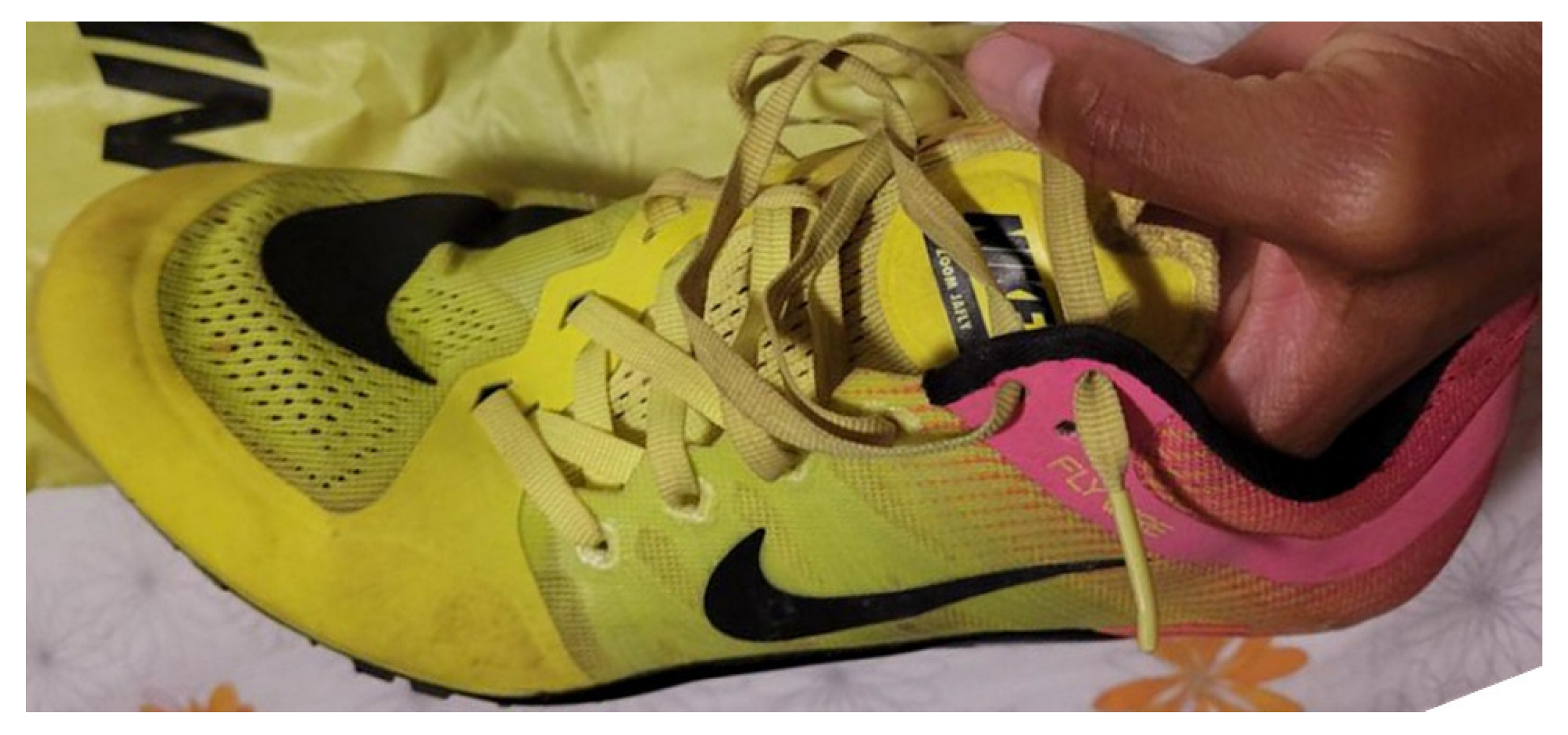
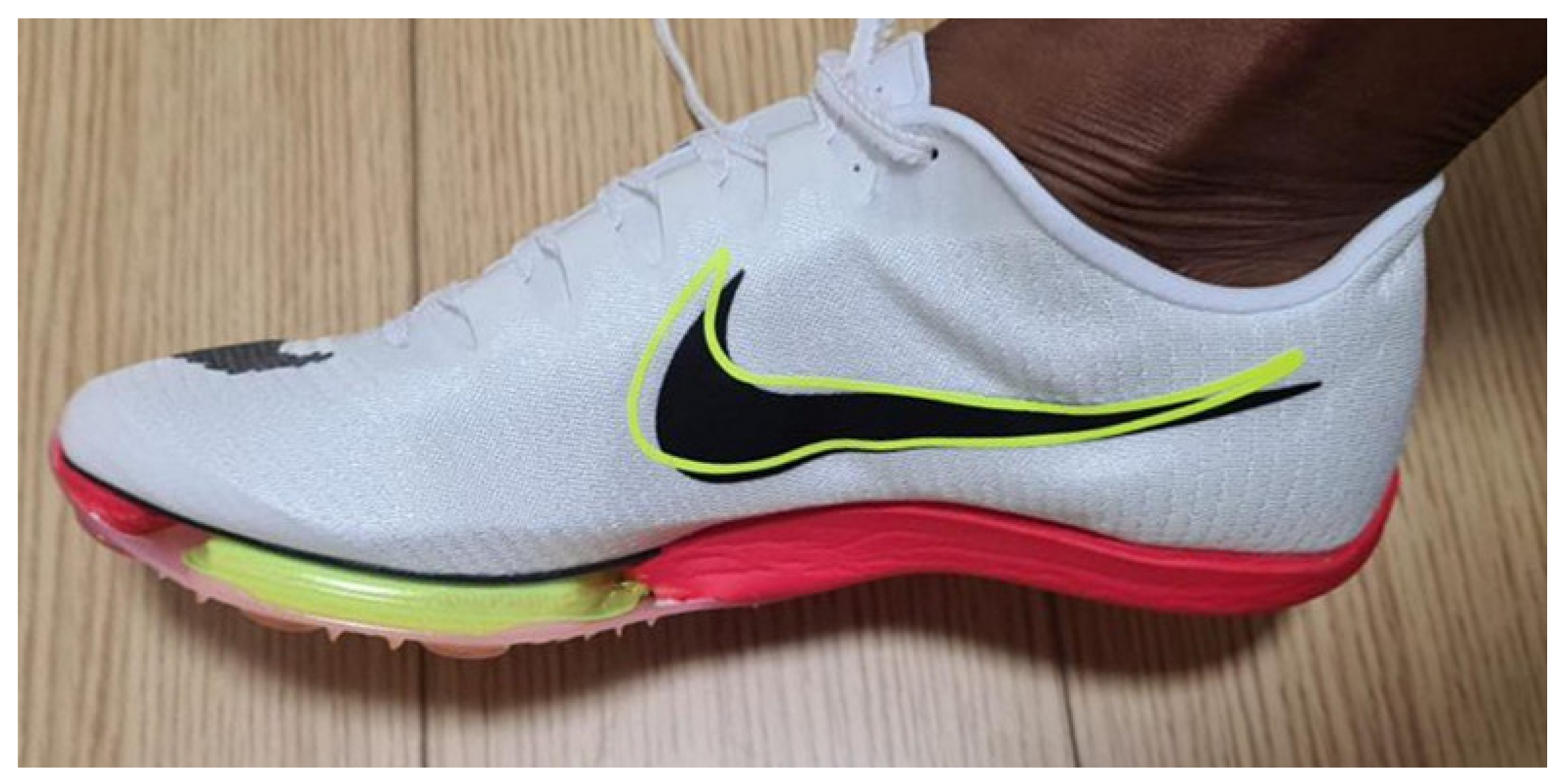
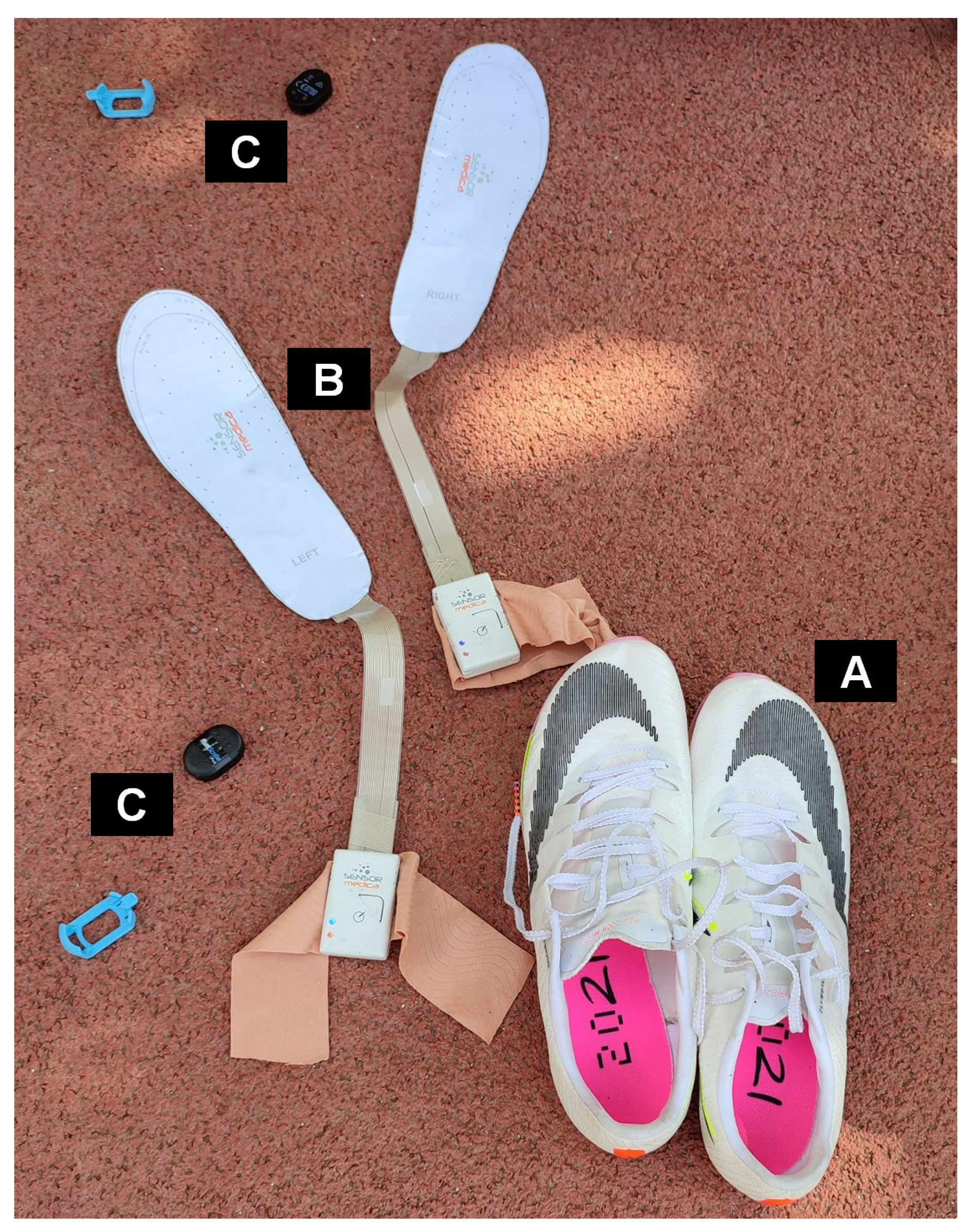
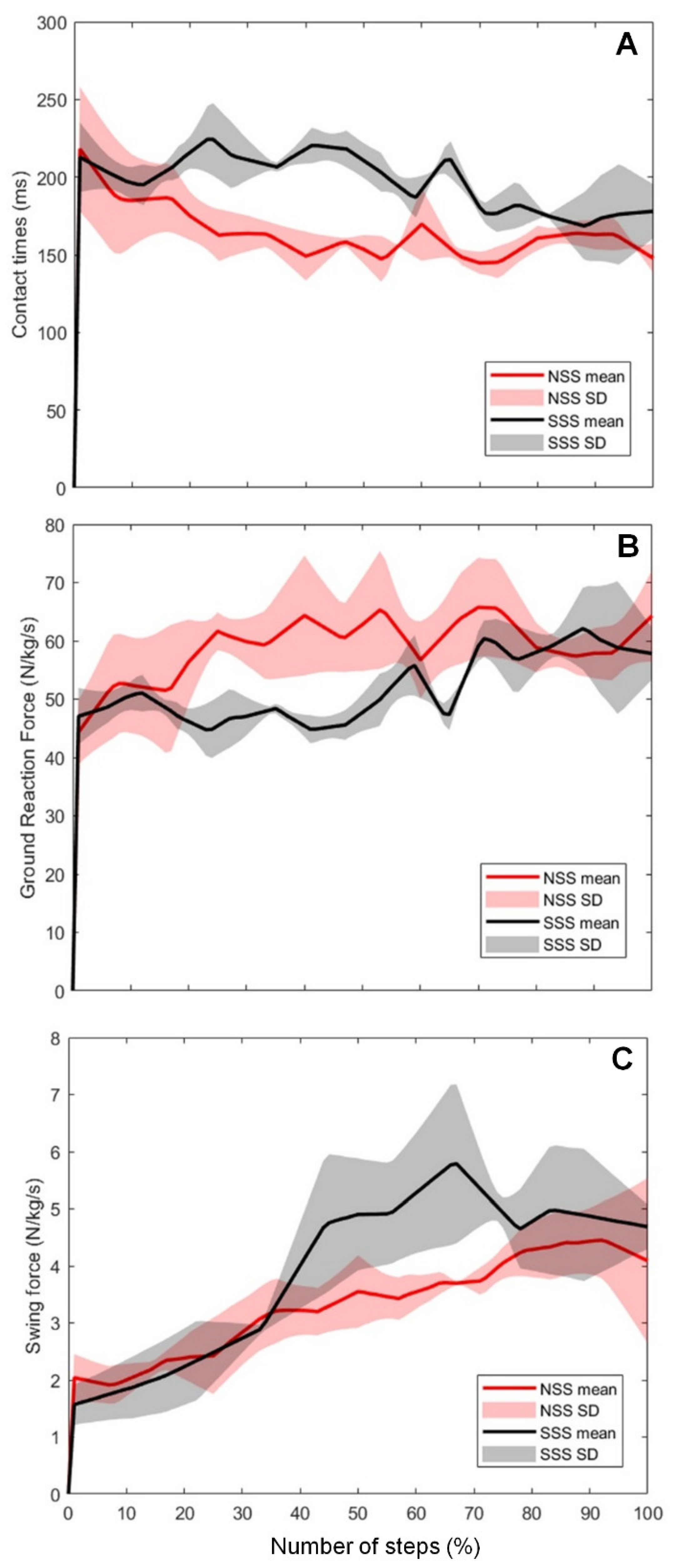
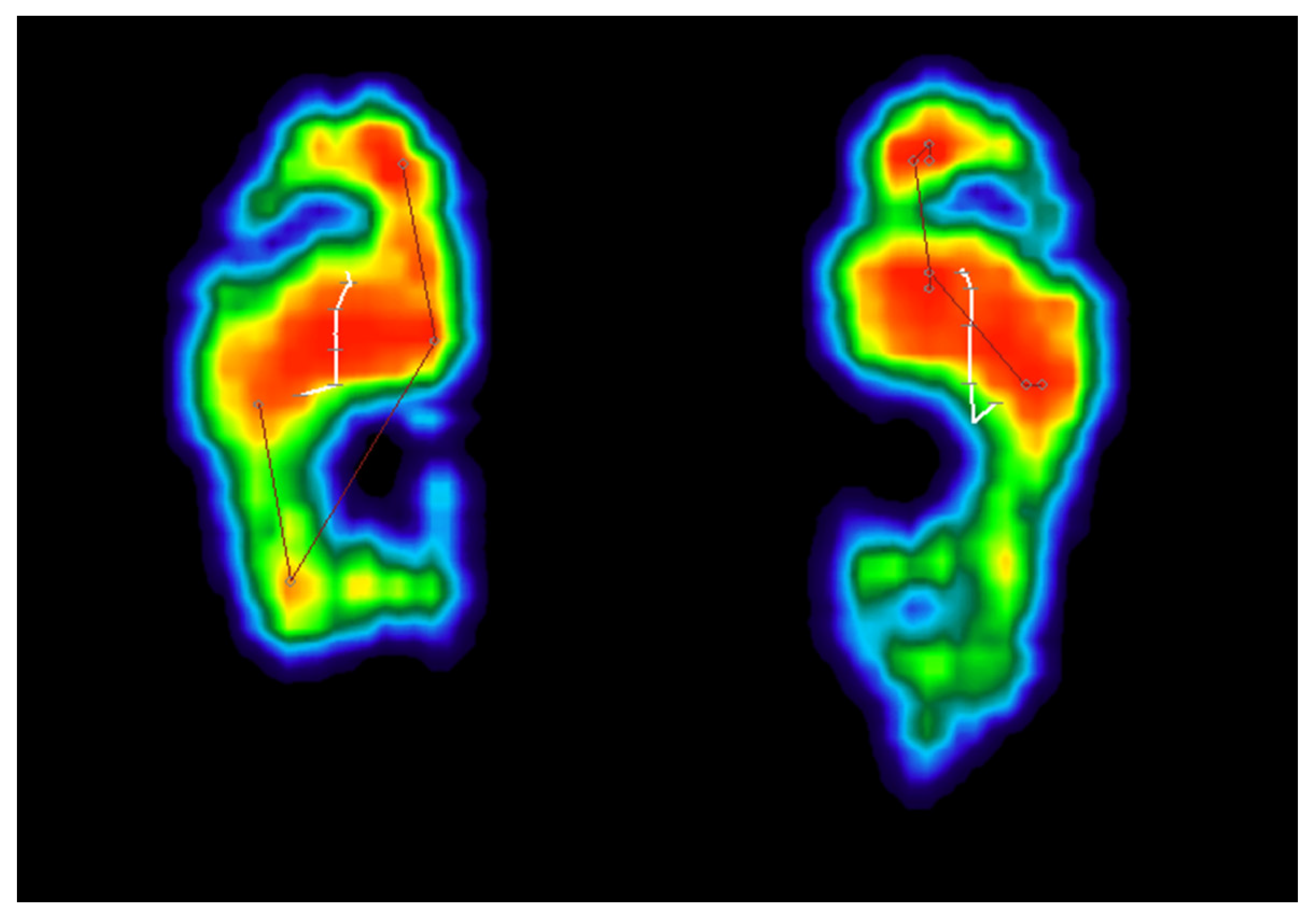
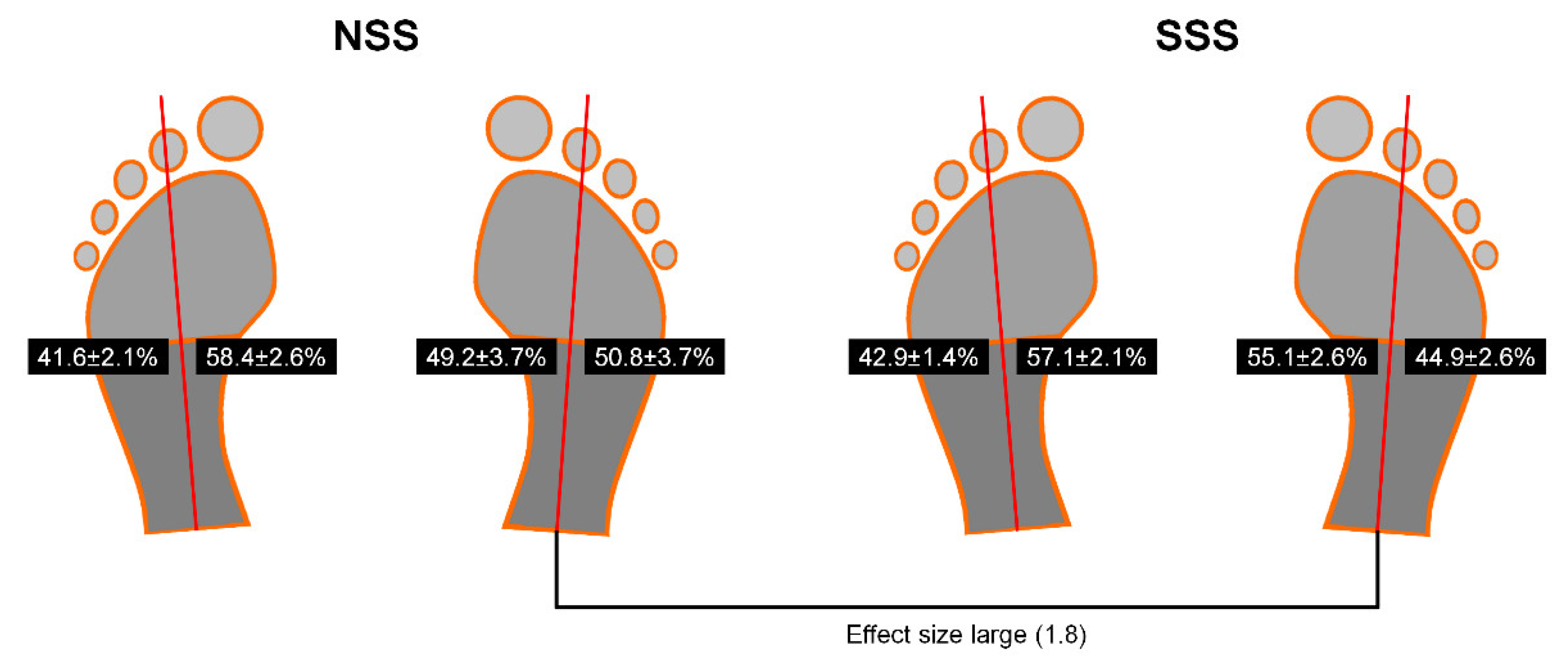
| Parameter | Unit of Measure | Description |
|---|---|---|
| Step rate | Steps/min | Number of steps taken per minute |
| Contact time | Milliseconds (ms) | Time spent on the ground during the foot contact phase |
| Step length | Meters (m) | Distance between two successive placements of different foot (right to left and left to right) |
| Vertical impact | Gravitational acceleration (G) | Amount of vertical acceleration at foot strike |
| Horizontal braking | Gravitational acceleration (G) | Amount of horizontal acceleration and braking at foot strike |
| Foot-strike type | Arbitrary Unit (a.u.) | Parameter assessed by the RunScribe that ranged from 0 to 15 to give a resume of the foot strike tendency; 0–6 heel strike, 6–9 mid foot strike, 9–15 fore foot strike [14] |
| Vertical ground reaction force rate (VGRFR) | Newton per kilos per seconds (N/kg/s) | Mean vertical force rate during stance |
| Swing force rate | Newton per kilos per seconds (N/kg/s) | Mean force rate to swing the limb in a stride |
| Foot plantar surface | Centimeters squared (cm2) | Foot plantar surface |
| Medial load percentage | % | Percentage of surface and pressure load in the medial area of the foot during each step |
| Lateral load percentage | % | Percentage of surface and pressure load in the lateral area of the foot during each step |
| Variables | NSS (Mean ± S.D.) | SSS (Mean ± S.D.) | Effect Size |
|---|---|---|---|
| Step rate (step/min) | 235.3 ± 9.5 | 241.3 ± 8.1 | 0.68 |
| Contact time (ms) | 168.3 ± 9.1 | 196.3 ± 5.7 | 3.70 ** |
| Step length (m) | 2.0 ± 0.1 | 2.0 ± 0.1 | 0.09 |
| Vertical impact (G) | 7.4 ± 0.8 | 12.8 ± 0.6 | 7.86 ** |
| Horizontal braking (G) | 10.5 ± 0.7 | 10.5 ± 0.4 | 0.00 |
| Foot strike type (a.u.) | 11.3 ± 2.1 | 4.0 ± 2.0 | 3.62 ** |
| Vertical ground reaction force rate (N/kg/s) | 61.9 ± 1.6 | 52.2 ± 1.0 | 7.21 ** |
| Swing force (N/kg/s) | 3,4 ± 0.6 | 4.1 ± 0.4 | 1.31 * |
| Variables | NSS (Mean ± S.D.) | SSS (Mean ± S.D.) | Effect Size | |
|---|---|---|---|---|
| Left foot | Plantar surface (cm2) | 138.1 ± 6.7 | 139.7 ± 8.6 | 0.2 |
| Medial loading (%) | 58.4 ± 2.6 | 57.1 ± 2.1 | 0.6 | |
| Lateral loading (%) | 41.6 ± 2.1 | 42.9 ± 1.4 | 0.6 | |
| Right foot | Plantar surface (cm2) | 146.1 ± 10.7 | 147.0 ± 7.0 | 0.1 |
| Medial loading (%) | 49.2 ±3.7 | 55.1 ± 2.6 | 1.8 * | |
| Lateral loading (%) | 50.8 ± 3.7 | 44.9 ± 2.6 | 1.8 * |
Publisher’s Note: MDPI stays neutral with regard to jurisdictional claims in published maps and institutional affiliations. |
© 2022 by the authors. Licensee MDPI, Basel, Switzerland. This article is an open access article distributed under the terms and conditions of the Creative Commons Attribution (CC BY) license (https://creativecommons.org/licenses/by/4.0/).
Share and Cite
Russo, L.; Montagnani, E.; Buttari, D.; Ardigò, L.P.; Melenco, I.; Larion, A.; Migliaccio, G.M.; Padulo, J. Track Running Shoes: A Case Report of the Transition from Classical Spikes to “Super Spikes” in Track Running. Appl. Sci. 2022, 12, 10195. https://doi.org/10.3390/app122010195
Russo L, Montagnani E, Buttari D, Ardigò LP, Melenco I, Larion A, Migliaccio GM, Padulo J. Track Running Shoes: A Case Report of the Transition from Classical Spikes to “Super Spikes” in Track Running. Applied Sciences. 2022; 12(20):10195. https://doi.org/10.3390/app122010195
Chicago/Turabian StyleRusso, Luca, Eleonora Montagnani, Daniel Buttari, Luca Paolo Ardigò, Ionel Melenco, Alin Larion, Gian Mario Migliaccio, and Johnny Padulo. 2022. "Track Running Shoes: A Case Report of the Transition from Classical Spikes to “Super Spikes” in Track Running" Applied Sciences 12, no. 20: 10195. https://doi.org/10.3390/app122010195
APA StyleRusso, L., Montagnani, E., Buttari, D., Ardigò, L. P., Melenco, I., Larion, A., Migliaccio, G. M., & Padulo, J. (2022). Track Running Shoes: A Case Report of the Transition from Classical Spikes to “Super Spikes” in Track Running. Applied Sciences, 12(20), 10195. https://doi.org/10.3390/app122010195










